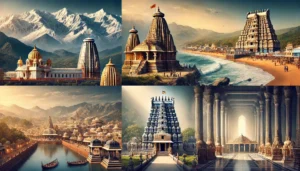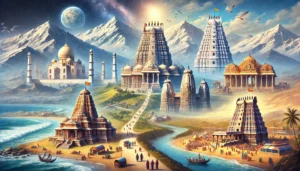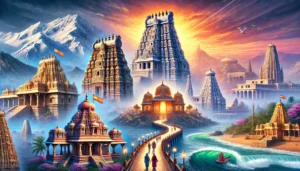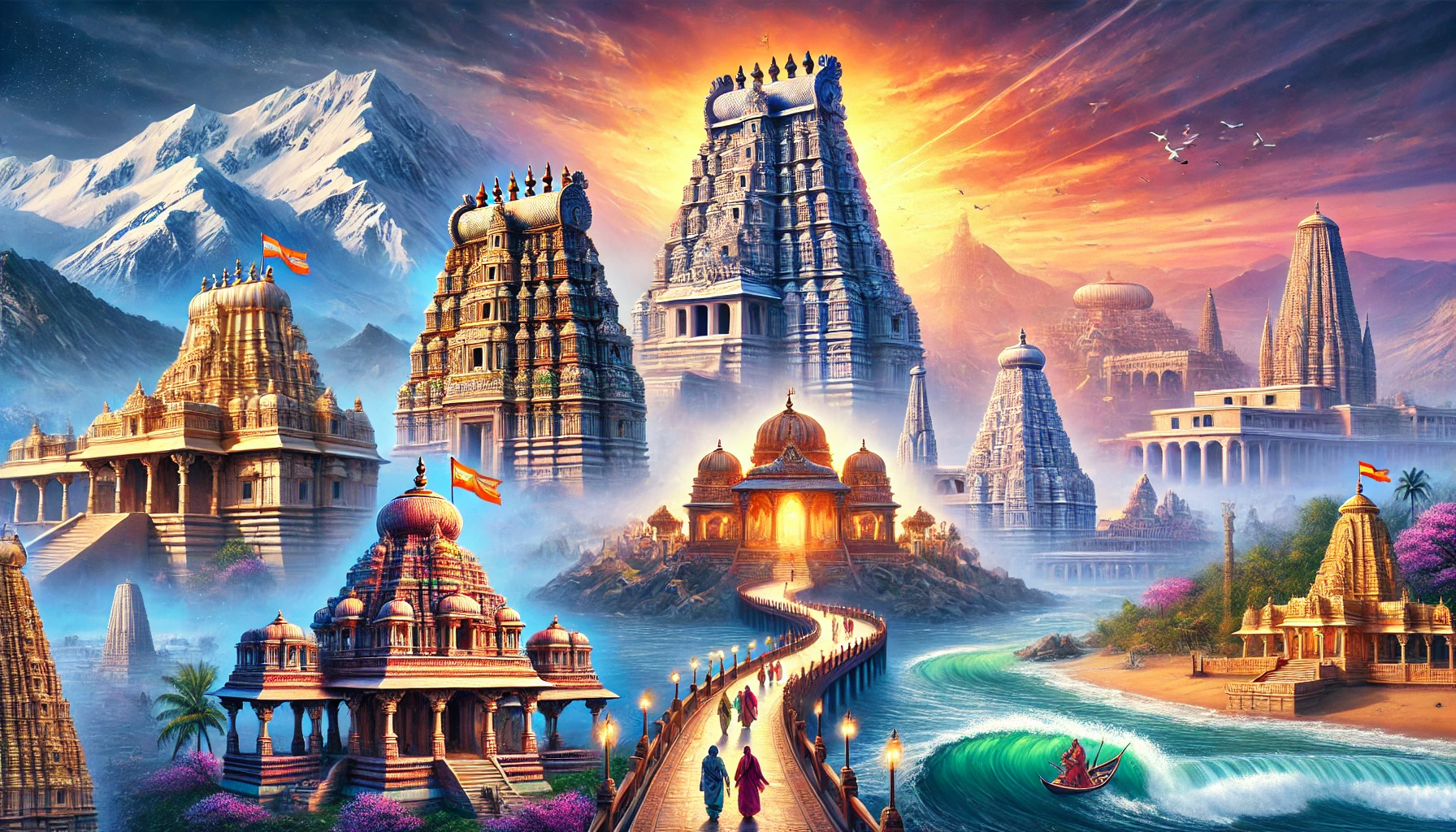
Importance of Char Dham in Hindu culture
The Char Dhams: Spiritual Significance and Pilgrim Journey
India, the land of spirituality and ancient traditions, is home to countless sacred pilgrimage sites. Among them, the Char Dhams—Badrinath, Dwarka, Puri, and Rameswaram—hold a unique place in Hinduism. These four dhams, spread across the north, west, east, and south of India, were established by Adi Shankaracharya in the 8th century CE to unify Hindu beliefs and guide devotees toward spiritual enlightenment. A pilgrimage to these dhams is believed to cleanse sins, grant moksha (liberation from the cycle of birth and death), and strengthen one’s devotion to the divine.
Historical and Mythological Significance of the Char Dhams
Each of the Char Dhams is deeply rooted in Hindu mythology and scriptures. These sacred sites have been mentioned in epics like the Ramayana, Mahabharata, Bhagavata Purana, and Vishnu Purana. Adi Shankaracharya, the great philosopher and saint, established the Char Dham pilgrimage circuit to reinforce the unity of Hinduism and encourage spiritual awakening.
Table of Contents

Importance of Char Dham in Hindu culture
Spiritual Significance of the Char Dhams
Each dham represents a divine presence and has profound religious importance:
- Badrinath (Uttarakhand) – The Abode of Lord Vishnu
Badrinath is situated in the Himalayan region of Uttarakhand, on the banks of the Alaknanda River. It is dedicated to Lord Vishnu, who is worshipped here as Badrinarayan. According to Hindu scriptures, Vishnu meditated in Badrinath under the Badri tree, performing penance for the welfare of humanity. Goddess Lakshmi is believed to have transformed herself into the tree to provide him shade.
Badrinath is also associated with Nar-Narayan, two forms of Vishnu who performed penance here. Additionally, the Pandavas from the Mahabharata are said to have visited Badrinath on their way to Swargarohini (the path to heaven).
Key Attractions in Badrinath
- Badrinath Temple – The main shrine of Lord Badrinarayan.
- Tapt Kund – A hot water spring with medicinal properties.
- Mana Village – The last village before the Indo-Tibetan border.
- Charan Paduka – A rock with Lord Vishnu’s footprints.
2. Dwarka (Gujarat) – The Kingdom of Lord Krishna
Located in Gujarat on the western coast of India, Dwarka is the legendary kingdom of Lord Krishna, also known as Dwarkadhish (King of Dwarka). According to mythology, after leaving Mathura, Krishna established his kingdom in Dwarka, which was later submerged in the ocean after his departure from Earth.
Dwarka is also one of the Sapta Puris (seven ancient holy cities) and is mentioned in texts like the Harivamsa and Bhagavata Purana. The city was once a grand kingdom built by Vishwakarma, the celestial architect.
Key Attractions in Dwarka
- Dwarkadhish Temple – Dedicated to Lord Krishna.
- Bet Dwarka – Believed to be Krishna’s residence.
- Rukmini Devi Temple – Dedicated to Krishna’s consort.
- Gomti Ghat – A sacred bathing site.
3. Puri (Odisha) – The Divine Abode of Lord Jagannath
Puri, located on the eastern coast of Odisha, is home to the Jagannath Temple, one of the most revered Vaishnavite shrines. Here, Lord Jagannath (a form of Vishnu) is worshipped alongside his siblings Balabhadra (Balarama) and Subhadra.
The Rath Yatra (Chariot Festival) is the most famous event in Puri, attracting millions of devotees. During this festival, the deities are taken in grand processions on huge chariots, symbolizing their journey to their aunt’s home.
The temple’s kitchen, known as Ananda Bazaar, is one of the largest kitchens in the world, preparing Mahaprasad, which is offered to devotees.
Key Attractions in Puri
- Jagannath Temple – The main temple of Lord Jagannath.
- Gundicha Temple – The destination of the Rath Yatra.
- Puri Beach – A sacred beach for rituals and meditation.
4. Rameswaram (Tamil Nadu) – The Sacred Jyotirlinga
Rameswaram, in Tamil Nadu, is associated with both Lord Shiva and Lord Rama. It is believed that Lord Rama, before crossing the ocean to Lanka, established a Shiva Linga here and prayed to Lord Shiva for victory over Ravana. This Jyotirlinga, known as Ramanathaswamy, is one of the twelve Jyotirlingas in India.
The temple is known for its 1,000-pillared corridor, which is an architectural marvel. Pilgrims take a sacred bath in the 22 theerthams (holy water tanks) before visiting the main shrine, as it is believed to purify the soul.
Key Attractions in Rameswaram
- Ramanathaswamy Temple – One of the twelve Jyotirlingas.
- Agni Theertham – A sacred bathing spot.
- Pamban Bridge – A historic bridge connecting Rameswaram to mainland India.
The Char Dham Pilgrimage: A Path to Liberation
Traditional Route of the Yatra
The Char Dham Yatra is traditionally undertaken in a clockwise direction:
- Puri (East)
- Rameswaram (South)
- Dwarka (West)
- Badrinath (North)
This journey is believed to lead a devotee toward spiritual fulfillment and moksha (liberation from rebirth).
Benefits of Undertaking the Char Dham Yatra
- Spiritual Cleansing – Bathing in the sacred waters of these shrines is believed to wash away sins.
- Attaining Moksha – Visiting all four dhams liberates the soul from the cycle of rebirth.
- Divine Blessings – Devotees receive the blessings of Lord Vishnu, Krishna, Shiva, and Jagannath.
- Connection with Hindu Heritage – The journey strengthens faith and connects one with India’s rich spiritual traditions.

Importance of Char Dham in Hindu culture
Conclusion
The Char Dham Yatra is not just a physical journey but a deeply transformative experience. It offers an opportunity for self-reflection, devotion, and divine connection. Pilgrims who embark on this sacred voyage seek not only divine blessings but also spiritual enlightenment and liberation from worldly attachments.
For those devoted to Hindu traditions, visiting the Char Dhams at least once in a lifetime is considered highly auspicious. Whether undertaken in one trip or over several years, the journey leaves a lasting impact on the soul, reinforcing faith and devotion to the eternal Sanatan Dharma.
Have you embarked on the Char Dham Yatra? Share your experiences and insights in the comments!
FAQs on The Char Dhams: A Sacred Pilgrimage and Its Spiritual Essence
- What are the Char Dhams?
The Char Dhams refer to four sacred pilgrimage sites in Hinduism, located in different parts of India:
- Badrinath (Uttarakhand) – Dedicated to Lord Vishnu
- Dwarka (Gujarat) – Dedicated to Lord Krishna
- Jagannath Puri (Odisha) – Dedicated to Lord Jagannath (a form of Krishna)
- Rameswaram (Tamil Nadu) – Dedicated to Lord Shiva
These sites were established as a pilgrimage circuit by Adi Shankaracharya in the 8th century to promote spiritual unity.
- What is the significance of the Char Dham Yatra?
The Char Dham Yatra is believed to cleanse the soul and help devotees attain moksha (liberation from the cycle of rebirth). Each site represents a different aspect of divine energy, making the pilgrimage spiritually fulfilling.
- What is the difference between Char Dham and Chota Char Dham?
- Char Dham refers to the four major pilgrimage sites across India (Badrinath, Dwarka, Puri, Rameswaram).
- Chota Char Dham is a smaller pilgrimage circuit in Uttarakhand, comprising Badrinath, Kedarnath, Gangotri, and Yamunotri.
4. When is the best time to visit the Char Dhams?
- Badrinath & Kedarnath: May to October (closed in winter due to snow)
- Dwarka & Puri: Open year-round, but best visited from October to March
- Rameswaram: Can be visited any time, though October to April offers pleasant weather
5. What is the ideal route for Char Dham Yatra?
Traditionally, devotees start from the easternmost site and move westward:
- Puri (Odisha) → 2. Rameswaram (Tamil Nadu) → 3. Dwarka (Gujarat) → 4. Badrinath (Uttarakhand)
6. Is it necessary to visit all four Dhams in one journey?
No, it is not mandatory, but visiting all four is considered highly auspicious. Many devotees complete the pilgrimage in multiple trips over their lifetime.
- How can one prepare for the Char Dham Yatra?
- Physical fitness: Some sites require trekking (e.g., Kedarnath).
- Weather preparedness: Carry appropriate clothing for varied climates.
- Spiritual preparation: Maintain a devotional mindset and follow temple customs.
- Booking & permits: Check travel guidelines, book accommodations, and obtain necessary permits if required.
8. What rituals should be followed at each Char Dham?
- Badrinath: Take a dip in the Tapt Kund (hot spring) before darshan.
- Dwarka: Visit Rukmini Temple and Gomti Ghat before entering the main temple.
- Puri: Participate in the Mahaprasad and Rath Yatra (if visiting during the festival).
- Rameswaram: Perform the sacred bath in the 22 holy wells and offer prayers at the Ramanathaswamy Temple.
9. Can elderly or physically challenged devotees undertake the Char Dham Yatra?
Yes, but they should plan carefully. Helicopter services, palkis, and ponies are available at certain locations like Kedarnath. Medical facilities are also available at major pilgrimage sites.
- What are the benefits of completing the Char Dham Yatra?
- Spiritual purification and divine blessings
- Removal of past sins and karmic burdens
- Attaining peace, prosperity, and ultimately moksha
The Char Dham Yatra is not just a physical journey but a path to inner transformation and divine connection.
Summary
The Char Dhams: A Sacred Pilgrimage and Its Spiritual Essence
The Char Dham pilgrimage is one of the most revered spiritual journeys in Hinduism, comprising four sacred temples located in the four cardinal directions of India: Badrinath (North), Dwarka (West), Jagannath Puri (East), and Rameswaram (South). Established by Adi Shankaracharya in the 8th century CE, this pilgrimage is believed to be a path to salvation (moksha), cleansing devotees of their past sins and leading them toward spiritual enlightenment.
Spiritual Significance of the Char Dhams
- Badrinath (North – Uttarakhand): The Abode of Lord Vishnu
Situated in the Garhwal Himalayas, Badrinath is dedicated to Lord Vishnu (Badrinarayan) and symbolizes moksha (liberation). It is believed that Adi Shankaracharya discovered the idol of Lord Vishnu in the Alaknanda River and installed it in the temple. The presence of the sacred Tapt Kund (hot water spring) and the Nar-Narayan Parvat makes this place spiritually powerful. - Dwarka (West – Gujarat): The Kingdom of Lord Krishna
Dwarka, meaning “Gateway to Heaven,” is the legendary city associated with Lord Krishna, who ruled here after leaving Mathura. The Dwarkadhish Temple, built over 2,500 years ago, signifies dharma (righteousness) and devotion to Krishna as the supreme being. It is believed that Dwarka was submerged after Krishna’s departure from Earth, yet its spiritual energy remains intact. - Jagannath Puri (East – Odisha): The Land of Devotion
Home to Lord Jagannath (a form of Vishnu/Krishna), the Jagannath Temple is one of the most significant pilgrimage sites in India. The temple is famous for its Rath Yatra (Chariot Festival), where millions of devotees gather to witness the deities being carried in massive chariots. The temple embodies bhakti (devotion), emphasizing surrender to divine grace. - Rameswaram (South – Tamil Nadu): Lord Shiva’s Sacred Jyotirlinga
Rameswaram is a major Shaivite pilgrimage site where Lord Rama worshipped Lord Shiva before crossing the sea to Lanka. The Ramanathaswamy Temple, housing one of the 12 Jyotirlingas, signifies karma (duty) and the unity of Vaishnavism and Shaivism. The Agni Theertham, a sacred water body near the temple, is believed to purify the soul.
The Spiritual Essence of the Char Dham Yatra
The Char Dham pilgrimage is more than just a religious journey—it is a path toward self-purification, inner awakening, and divine connection. Each temple represents a vital aspect of spiritual growth:
- Badrinath signifies wisdom and liberation (jnana and moksha).
- Dwarka embodies righteous living (dharma).
- Puri emphasizes devotion and surrender (bhakti).
- Rameswaram symbolizes duty and penance (karma).
Hindus believe that undertaking this sacred yatra cleanses one’s soul, removes past sins, and brings them closer to attaining moksha (liberation from the cycle of rebirth). The journey is not just about visiting temples but also about understanding the deeper meaning of life, surrendering to the divine will, and achieving spiritual fulfillment.
Thus, the Char Dham Yatra remains an eternal beacon of faith, devotion, and enlightenment, uniting millions of pilgrims in their quest for divine blessings.
Unlock the Ancient Wisdom of Sanatan Dharma – Join Us on YouTube!
👉 Subscribe now to Prachin Sanatan Dharma and embark on a journey of enlightenment.
Explore timeless teachings, spiritual insights, and cultural richness on our YouTube channel, Prachin Sanatan Dharma. Dive deep into the essence of Sanatan Dharma through captivating videos that inspire and educate.
Related Articles
- Restful Nights: Ayurvedic Remedies and Traditional Indian Practices to Overcome Insomnia and Late-Night Habits
- The Tridevi: Lakshmi, Saraswati, and Parvati – Their Roles and Powers
- “Divine Creatures of Ancient Indian Scriptures: Exploring the Role of Animals in the Vedas, Puranas, and Mahabharata”
- Nature and Spirituality: Exploring the Sacred Essence of the Himalayas, Ganga, and Other Natural Wonders”
- “Reviving the Gurukul System: Relevance and Lessons for Modern Education”
- “Exploring Greek and Indian Mythology: Similarities Between Greek and Indian Mythology “
- “Embracing Sattvic Living: Harmonizing Mind, Body, and Soul Through Food and Lifestyle”
- “Charity and Prosperity: Exploring the Concept of Daan and Its Financial Relevance in Modern Life”
- How to Build an Eco-Friendly Home Inspired by Vastu Shastra
- Comparison of Ancient and Modern Sports: How Traditional Sports Have Influenced Contemporary Games
- “Timeless Lessons from Ancient Tales: Linking Samudra Manthan and Ganga’s Descent to Modern Ecological Challenges”
- “Reviving Sanskrit: How AI is Preserving Ancient Languages for the Future”
- “Mathura: The Sacred Land of Lord Krishna’s Divine Leelas”
- Investing for Future Generations: Lessons from Indian Traditions on Legacy Building and Wealth Preservation
- “Ancient Indian Wisdom: Timeless Lessons for Tackling Today’s Climate Crisis”
- “Artificial Intelligence and Spirituality: Transforming Ancient Practices for the Modern World”
- “Gold and Real Estate in India: Timeless Assets Shaping Financial Strategies”
- Tradition Meets Innovation: The Evolution of Technology in Hindu Rituals
- End-of-World Myths: Exploring Kali Yuga in Hinduism and Ragnarök in Norse Mythology
- Garuda, Pegasus, and Dragons: The Universal Ties of Mythical Beasts Across Cultures
- “Ancient Vimanas: Mythical Flying Machines or Evidence of Advanced Technology?”
- Time Travel in Hindu Mythology: The Fascinating Tales of Kakudmi and King Raivata
- “Divine Feminine Power in Hindu Mythology: The Legends of Durga, Saraswati, and Lakshmi”
- “Divine Beings of Sanatan Dharma: The Spiritual Significance of Sacred Animals in Hinduism”
- “Symbolism in Mythological Art: Unlocking Hidden Meanings in Ancient Temple Carvings”
- “Exploring Technological Advancements in Ancient India and Civilizations: Vimana, Metallurgy, & Water Management systems”
- Unveiling the Mysteries: Ancient Temples of Sanatan Dharma , Mysterious Temples of India
- “The Scientific Knowledge of Sanatan Dharma: Ancient Wisdom Meets Modern Science”
- Ancient Indian Sports and Games: Celebrating a Legacy of Skill, Strength & Strategy”
- “Exploring the Cosmic Link: The Connection Between Astronomy and Vedic Astrology”
- The Power of Sanskrit: Unlocking the Divine Language of the Gods
- “The End of Kaliyuga: A Sanatan Insight into the World’s Final Chapter”
- Explore more articles on Prachin Sanatan Yuga.
Importance of Char Dham in Hindu culture Importance of Char Dham in Hindu culture Importance of Char Dham in Hindu culture Importance of Char Dham in Hindu culture Importance of Char Dham in Hindu culture Importance of Char Dham in Hindu culture Importance of Char Dham in Hindu culture Importance of Char Dham in Hindu culture Importance of Char Dham in Hindu culture Importance of Char Dham in Hindu culture
Importance of Char Dham in Hindu culture Importance of Char Dham in Hindu culture Importance of Char Dham in Hindu culture Importance of Char Dham in Hindu culture Importance of Char Dham in Hindu culture Importance of Char Dham in Hindu culture Importance of Char Dham in Hindu culture Importance of Char Dham in Hindu culture Importance of Char Dham in Hindu culture Importance of Char Dham in Hindu culture
Importance of Char Dham in Hindu culture Importance of Char Dham in Hindu culture Importance of Char Dham in Hindu culture Importance of Char Dham in Hindu culture Importance of Char Dham in Hindu culture Importance of Char Dham in Hindu culture Importance of Char Dham in Hindu culture Importance of Char Dham in Hindu culture Importance of Char Dham in Hindu culture Importance of Char Dham in Hindu culture
